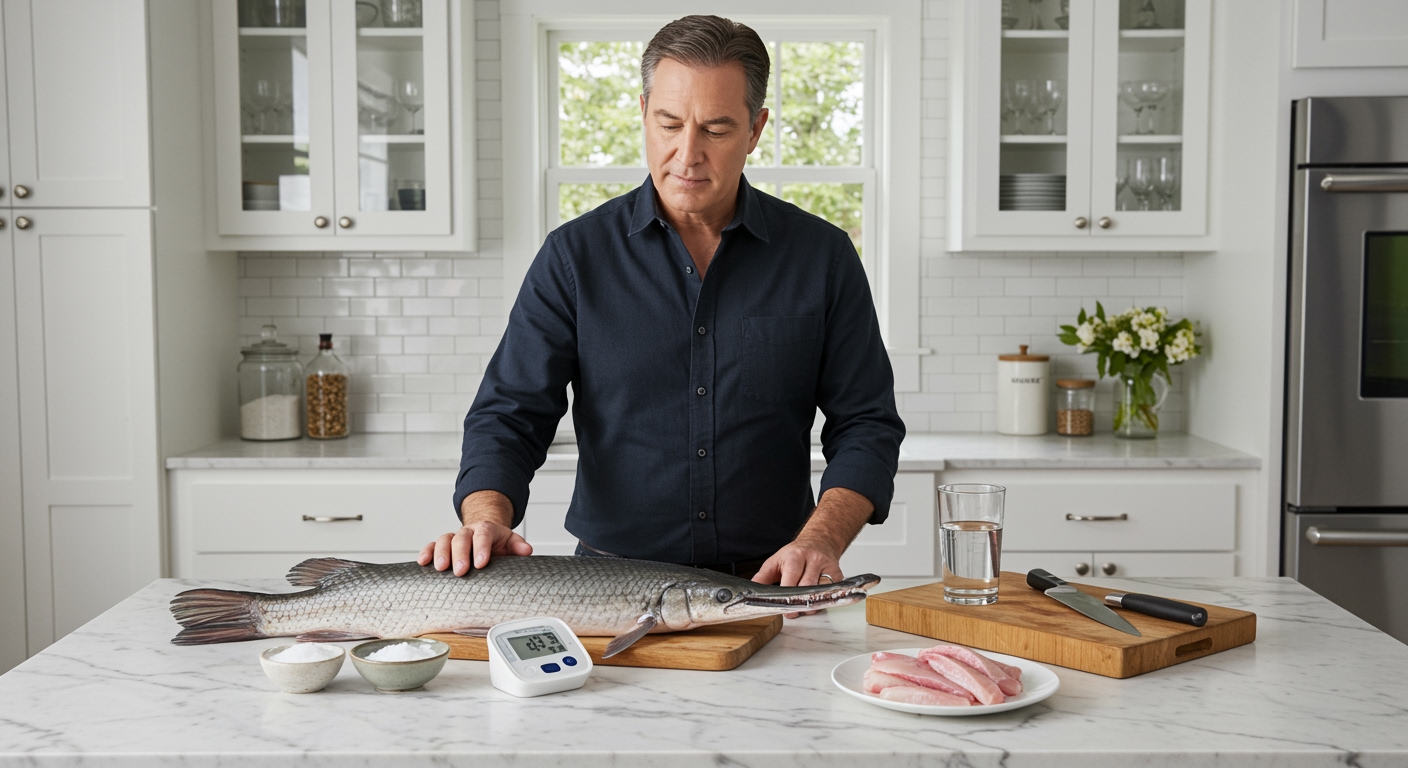✪ Key Takeaway: Bowfin fish contains omega-3 fatty acids that may help stabilize blood pressure, but limited research exists on this specific fish.
Introduction
You walk into a fish market and see something called bowfin for the first time.
Maybe your doctor told you to eat more fish for your blood pressure, or perhaps you heard somewhere that this ancient fish has special health benefits.
Hi, I’m Abdur, your nutrition coach and today I’m going to explain whether eating bowfin can actually help stabilize your blood pressure and what the science really says about this unique fish.
What Makes Bowfin Different From Other Fish?
Bowfin is not your typical grocery store fish.
This ancient species has survived for over 150 million years, making it older than many dinosaurs.
Scientists call bowfin a living fossil because it represents one of the oldest fish lineages still swimming in North American waters today.
The fish lives in freshwater environments like swamps, marshes, and slow-moving rivers throughout the eastern United States.
Unlike salmon or tuna that people commonly eat for heart health, bowfin has a unique nutritional profile that researchers have barely studied.
Most people describe its taste as mild and flaky, similar to bass or pike, but with a slightly firmer texture that holds up well during cooking.
✪ Fact: Bowfin can breathe air and survive in water with very low oxygen levels, unlike most other fish species.
How Do Omega-3 Fatty Acids Affect Blood Pressure?
Your blood pressure depends on how easily blood flows through your arteries.
When your arteries become stiff or narrow, your heart must work harder to pump blood, which increases pressure against artery walls.
Omega-3 fatty acids help your body produce compounds called prostaglandins that relax blood vessel walls and improve blood flow.
These healthy fats also reduce inflammation throughout your cardiovascular system, which prevents arteries from becoming damaged and hardened over time.
Research shows that people who eat fish twice per week have lower blood pressure and reduced risk of heart disease compared to those who rarely eat seafood.
The two most important omega-3s for blood pressure are EPA and DHA, which your body cannot make on its own and must come from food sources.
Most fish contain some amount of these beneficial fats, but the exact levels vary dramatically between different species and their living environments.
✪ Pro Tip: Cold-water fish typically contain higher omega-3 levels than warm-water species because they need these fats to maintain cell flexibility.
Does Bowfin Actually Contain Omega-3 Fatty Acids?
Here comes the challenging part about bowfin and blood pressure claims.
Very few studies have analyzed the exact nutritional content of bowfin compared to popular fish like salmon, mackerel, or sardines.
The limited research available suggests that bowfin does contain omega-3 fatty acids, but probably not in the same high concentrations found in cold-water ocean fish.
Freshwater fish generally have lower omega-3 levels than their saltwater cousins because their diet and environment differ significantly.
Bowfin primarily eats other freshwater fish, crayfish, and aquatic insects, which means its omega-3 content depends entirely on what those prey animals consumed.
One small study found that bowfin contains approximately 200-400 milligrams of omega-3s per 100-gram serving, which is moderate but not exceptional compared to other fish options.
For comparison, the same serving of salmon provides 1,500-2,000 milligrams of omega-3s, while sardines offer around 1,200 milligrams per serving.
✪ Note: The American Heart Association recommends 1,000 milligrams of omega-3s daily for people with existing heart disease.
What Other Nutrients In Bowfin Might Affect Blood Pressure?
Blood pressure control involves more than just omega-3 fatty acids.
Bowfin provides high-quality protein that helps maintain healthy blood vessel structure and supports proper kidney function, both crucial for blood pressure regulation.
Like most fish, bowfin contains potassium, a mineral that helps your kidneys remove excess sodium from your body through urine.
When you consume adequate potassium, your body maintains better fluid balance, which reduces the volume of blood your heart must pump and lowers pressure on artery walls.
Fish also provides magnesium, another mineral that helps relax smooth muscle in blood vessel walls and supports normal heart rhythm.
However, bowfin likely contains similar amounts of these minerals compared to other freshwater fish, so it does not offer any unique advantages in this regard.
The real benefit comes from choosing fish over processed meats, which are typically high in sodium and saturated fats that can raise blood pressure over time.
✪ Fact: One serving of processed lunch meat contains more sodium than most people should consume in an entire day.
Should You Choose Bowfin Over Other Fish For Blood Pressure?
The honest answer is probably not if blood pressure control is your primary goal.
While bowfin can certainly be part of a heart-healthy diet, other fish options provide more proven benefits for cardiovascular health.
Fatty fish like salmon, mackerel, sardines, and anchovies contain much higher omega-3 levels and have extensive research supporting their blood pressure benefits.
These fish consistently show up in studies demonstrating significant reductions in both systolic and diastolic blood pressure when consumed regularly.
If you enjoy bowfin or it is readily available in your area, eating it twice per week can contribute to your overall fish intake goals.
Just remember that you will likely need to eat larger portions or combine it with other omega-3 rich foods to achieve the same cardiovascular benefits.
The most important factor is choosing fresh, properly prepared fish over processed foods, regardless of the specific species you select.
✪ Pro Tip: Vary your fish choices throughout the week to maximize different nutrients and prevent mercury buildup from any single species.
The Bottom Line
Bowfin can be part of a blood pressure friendly diet, but it is not a magic solution for cardiovascular health.
The best fish for your health is the one you will actually eat consistently, combined with other proven lifestyle changes like reducing sodium intake and staying physically active.
I would love to hear about your experiences with different types of fish or any questions you have about nutrition and blood pressure management in the comments below.
References
At NutritionCrown, we use quality and credible sources to ensure our content is accurate and trustworthy. Below are the sources referenced in creating this article:
- PMC: Omega-3 fatty acids and cardiovascular disease
- PubMed: Fish consumption and blood pressure
- American Heart Association: Eating fish twice a week reduces heart stroke risk
- Wikipedia: Bowfin





